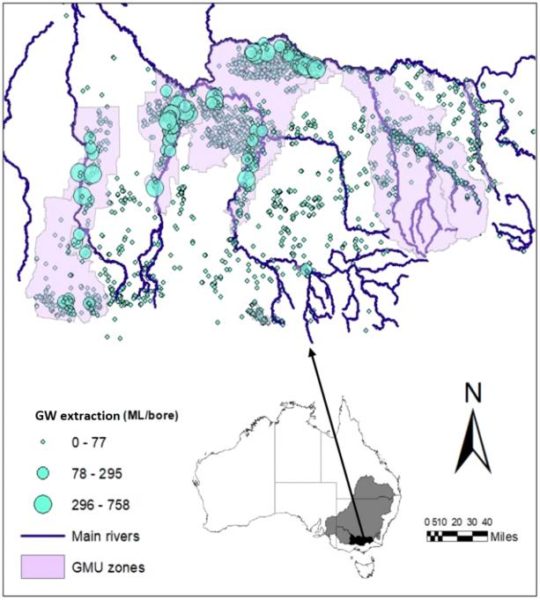Substituting groundwater for surface water – what could go wrong? A case study in Victoria, Australia

In many places there is evidence that some water users will sell off the surface water they are entitled to, but then make greater use of groundwater to satisfy their water needs. And, because surface water and groundwater are interconnected, but groundwater extraction poorly measured and monitored, it’s a form of substitution that could hurt others. It can also undermine water markets and affect water conservation efforts by governments. Sarah Ann Wheeler and colleagues have just analysed the interdependence between surface and groundwater extractions in an irrigation district in the Murray-Darling Basin, Australia. Here she explains what they did, and what it reveals.
In many countries around the world, groundwater is an important source for both drinking water and irrigation. However, global groundwater resources in arid and semi-arid regions face a common-pool problem and are at a growing risk of being depleted. In many regions around the world, the rate of groundwater extraction increasingly exceeds the recharge rate (Edwards 2016). Although it is expected that reduced surface-water availability due to climate change will increase future demand for groundwater resources, there has been less research to date on identifying the substitutability between surface- and groundwater extractions, especially in situations where substantial water markets exist (for both groundwater and surface water).
Aquifers closer to surface-water rivers have higher recharge and lower salinity issues, making the economics of pumping groundwater more profitable (Gill et al. 2017). In the US, groundwater extraction reduced flows in nearby surface-water streams, resulting in interstate conflict (Kuwayama & Brozović 2013). In China, Zhang (2007) found that groundwater extraction increased with redistribution of surface-water rights from agriculture to urban. Zhang (2007) suggested that surface-water trading schemes were ineffective in areas where surface and groundwater resources were in close proximity because irrigators reduced surface-water extraction, but increased groundwater extraction instead.
Hence, where there is conjunctive use of both surface and groundwater sources (Evans 2007), substitutability between sources can impact the effectiveness of water markets and government water recovery programs, especially if irrigators sell their surface-water to the government and compensate for the shortfall by increasing groundwater extraction (Wheeler & Cheesman 2013).
Our study modelled the factors associated with irrigation groundwater extraction data over a ten-year period from metered bores located in the Goulburn Murray Irrigation District – one of the largest irrigation regions in the Murray-Darling Basin, Australia. Because of its history and development of water markets over the past thirty years, the Murray-Darling Basin provides an ideal case study of the substitutability between groundwater and surface-water. Surface-water systems are inter-connected in the region, allowing surface-water trade between trading zones.
We analysed annual water extractions from 1,890 geocoded metered groundwater bores in the Goulburn Murray Irrigation District between 2007-08 and 2016-17, giving us 18,020 observations over time, and calculated the distance from the bore to the closest watercourse. Figure 1 illustrates the bores locations, and indicates the size of their groundwater volume extraction over the time-period. Most high-extraction bores are clustered along major watercourses.

Figure 1: Groundwater metered extraction from 2007-08 to 2016-17 mapped over surface-water rivers and groundwater (GMU) zones in the Goulburn Murray Irrigation District. (Source: based on data provided by Goulburn Murray Water)
Our models controlled for multiple factors influencing groundwater extraction. These included groundwater and surface water allocations (and entitlements) traded; rainfall; surface-water annual season end allocations; dryland salinity; diesel prices (input cost for pumping groundwater) and milk commodity prices (output prices for the main agricultural industry of dairy production in the region).
The modelling results found that over the ten year period, greater groundwater extraction was statistically significantly associated with: 1) groundwater bores located closer to surface-water sources; 2) lower surface-water availability (and rainfall); 3) higher surface-water temporary market prices; 4) higher surface-water permanent out-of-zone and lower surface-water temporary within-zone trading volumes; and 5) lower groundwater pumping costs and higher output commodity prices.
Hence, a close substitutability relationship between groundwater and surface water resources was found, and this relationship intensified in times of water scarcity and in the existence of water markets. The economics of lower input costs and higher output returns also drove greater groundwater extraction.
The coexistence and connectivity between ground- and surface-water resources presents major challenges for water policy. For example, government efforts to recover water for the environment may be ineffective if irrigators can sell surface-water rights, yet increase groundwater extraction to make up for the shortfall. It is worth noting that metered groundwater extractions in the district were within their limits, and most groundwater entitlement owners do not use their full groundwater allocations regularly. However, what our results highlight is that increasing surface water scarcity will lead to significant increases in groundwater extraction over time, and that increased use of permanent surface-water markets will increase groundwater extraction. Increased groundwater extraction is of particular concern the closer groundwater bores are to surface watercourses (namely where groundwater bores are recharged by surface water); and where water extraction is not fully measured, monitored and/or enforced, which has been raised as an issue within the Murray-Darling Basin. This is a particular issue for thousands of groundwater bores – particularly those known as basic rights (namely stock and domestic) (Wheeler et al. 2020). In addition, subsidisation of irrigation groundwater bore infrastructure by the Commonwealth and state governments will only incentivise increased groundwater extraction.
Given the interdependence and substitutability identified between different water sources, we suggest the many improvements in water governance that are needed include: a) the greater use of satellite and thermal imaging and measurement of all types of water extractions (and how their extraction changes over time); b) removal of all subsidies of bore establishment and irrigation infrastructure upgrades; c) the development of strong regional water resource plans to cover all water sources; d) increased metering, monitoring and enforcement; e) improved scientific knowledge on water hydrology and connectivity; and f) improved water trade products, appropriately designed and adaptable to account for changing human behaviour and other unintended consequences.
References:
Edwards E (2016). What Lies Beneath? Aquifer Heterogeneity and the Economics of Groundwater Management. Journal of the Association of Environmental and Resource Economists, 3: 453-491.
Evans R (2007). The impact of groundwater use on Australia’s rivers: technical report. Land & Water Australia, Braddon, ACT.
Gill B, J Webb, K Stott, X Cheng, R Wilkinson & B Cossens (2017). Economic, social and resource management factors influencing groundwater trade: evidence from Victoria, Australia. J. Hydrol. 550: 253–267.
Kuwayama Y & N Brozović (2013). The regulation of a spatially heterogeneous externality: Tradable groundwater permits to protect streams. Journal of Environmental Economics and Management 66: 364-382.
Wheeler S, E Carmody, Q Grafton, R Kingsford & A Zuo (2020). The Rebound Effect on Water Extraction from Subsidising Irrigation Infrastructure in Australia. Resources, Conservation and Recycling 157: 104755.
Wheeler S & J Cheesman (2013). Key findings from a survey of sellers to the ‘Restoring the Balance’ programme. Economic Papers: A journal of applied economics and policy 32: 340-352.
Wheeler S, Z Zuo & J Kandulu (2020). What Water are We Really Pumping? The Nature and Extent of Surface and Groundwater Substitutability in Australia and Implications for Water Management Policies. Applied Economic Perspectives and Policy.
https://onlinelibrary.wiley.com/doi/10.1002/aepp.13082
Zhang, J. 2007. Barriers to water markets in the Heihe River basin in northwest China. Agricultural Water Management 87: 32-40.
Originally published by the Global Water Forum, 2 December 2020.
